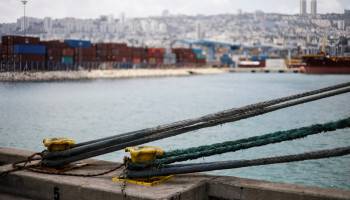Moldova’s Gas Crisis and Its Lessons for Europe
Pathways Towards a Net-Zero Emissions Power System for Hong Kong
LEAVE YOUR PHONE AT HOME: WHY EU ROAMING CHARGES WILL ONLY INCREASE FOR UK CONSUMERS
The Launch of the Haifa Bayport Terminal: Economic and Security Considerations
September 1, 2021, marked the official start of operations at the Haifa Bayport Terminal. In recent years, Israeli media publications have raised concerns about the port’s operation by a Chinese state-owned company, particularly in view of the growing rivalry between China and the United States. The official opening of the port is an opportunity to revisit the issue.
In a nutshell, the port operator is a private Israeli company, indeed owned by a Chinese company, yet most of its employees are Israelis, apart from a few Chinese management staff.
As for the concerns about disruption to port activity during emergencies or exertion of pressure on the Israeli government, the probability and severity of these risks appear to be limited:
– Bayport will not be owned by its operator;
– Bayport is subject to Israeli law and in emergencies must operate according to the instructions of the Israeli security authorities, just like Israel’s other ports;
– if the operator does not comply with these terms, it risks committing a breach of contract and the Government of Israel will be fully entitled to replace it.
As for espionage risks: for purposes of line-of-sight observation and reception, the Bayport Terminal is no nearer to the Israeli naval base than many civilian buildings in Haifa, yet its location on the water line does indeed offer the potential for gathering acoustic intelligence (signatures of vessels and especially submarines), a potential that exists in principle in transiting commercial vessels as well.
[ > Institute for National Security Studies — September 12, 2021 ]
AUSTRALIAN INVESTMENT IN HIGHER EDUCATION 2021
Over the past two decades, investment in Australian universities has grown almost without pause. In 2020, pandemics, border closures and government reforms of student funding arrangements have resulted in the higher education sector facing some of its greatest challenges.
Australian university profits plummeted by $1.6 billion to just $669 million. 15 of the 38 universities included in the analysis reported a deficit in 2020. Most of the universities that didn’t post a deficit barely broke even.
Almost all the sector’s surpluses were concentrated in Australia’s three largest universities:
– Monash University ($267 million);
– The University of Melbourne ($178 million);
– The University of Sydney ($107 million).
This suggests that it is the smaller and less prestigious universities that are finding the conditions the toughest. Without further support, parts of the university sector are likely to face very difficult choices that will mean further cuts to staffing, courses and research.
The impact of the pandemic on international students remains one of the biggest issues facing the sector. Border closures impact the ability of international students to return to Australia, and for new international students to enrol, disrupting a significant income source for universities. In the first six months of 2021, international student enrollments at public higher education institutions fell at an annualized rate of between 20% and 24%. If this rate were to continue, this roughly equates to about $2 billion to $2.4 billion in annual revenue across the university sector.
[ > Mitchell Institute for Education and Health Policy — August 30, 2021 ]





